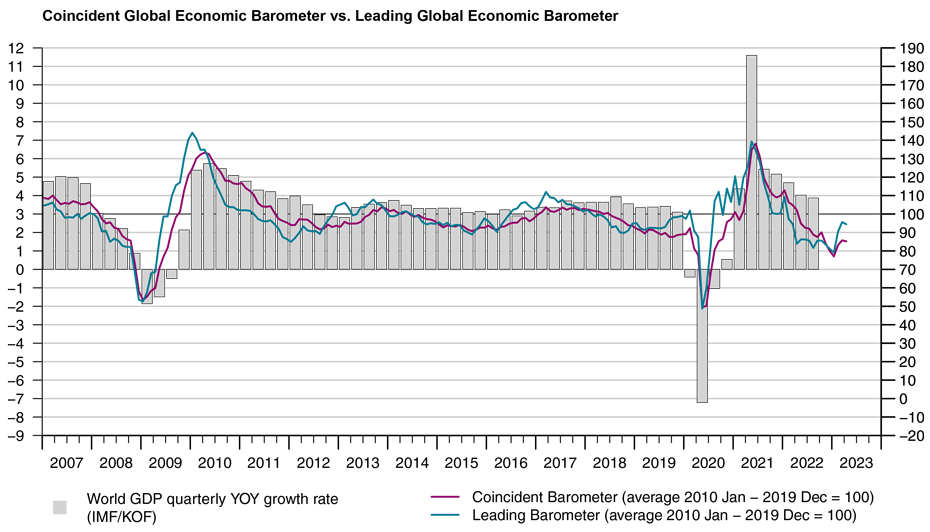Global Barometers fall slightly after rising for two months
The levels of the Global Barometers remained almost unchanged in April, halting the recovery tendency observed earlier this year. The result was mainly influenced by the Asia, Pacific & Africa region, where the indicators retreated after two noticeably rises.
In April 2023, the Coincident Global Economic Barometer falls by 0.5 point to 85.2 points, and the Leading Global Economic Barometer drops by 1.1 point to 94.5 points. The stabilization is mainly due to the drop of the indicators in the Asia, Pacific & Africa region. There was also a decline in the Western Hemisphere, while Europe moved in the opposite direction.
“Although the global economy, and the European economy in particular, did not suffer as much from the predicted energy crisis last winter, the recovery in global barometers now seems to have come to a halt. While the European signals continue to improve, the slower-than-hoped-for recovery of the Chinese economy in particular is weighing on the global economy. Moreover, the ongoing fight against inflation by central banks in many parts of the world is turning this recovery into one with the brakes on”, evaluates Jan-Egbert Sturm, Director at KOF Swiss Economic Institute.

“While the European signals continue to improve, the slower-than-hoped-for recovery of the Chinese economy in particular is weighing on the global economy.”Jan-Egbert Sturm, Director at KOF Swiss Economic Institute
Coincident Barometer – regions and sectors
In April, the Asia, Pacific & Africa region and the Western Hemisphere contribute -1.3 and -0.3 points, respectively, to the drop in the Coincident indicator, while Europe contributes positively with 1.1 points. The relative stability of the global indicator this month was partly motivated by the recent volatility of the indicators in China, which had been rising after the end of the zero-Covid policy. The graph below illustrates the contribution of each region to the deviation of the Coincident Barometer from its historical average of 100 points.
The Coincident sector indicators for Services, Industry, and the general state of the Economy (aggregated business and consumer evaluations) decrease this month, while Construction and Trade move in the opposite direction. The outstanding result of an increase of 14.8 points in the indicator for Construction markedly reduces the gap with the other sectors.
Leading Barometer – regions and sectors
The Leading Global Barometer leads the world economic growth rate cycle by an average of three to six months. The regional results of the Leading indicator follow the same tendency as that of the Coincident Barometer, with the Asia, Pacific & Africa region and the Western Hemisphere contributing negatively with -2.3 points and -0.2 point, respectively, to the overall decline of 1.1 points, while Europe makes a positive contribution of 1.4 points.
All the Leading indicator sectors decrease in April, except Construction, which increases for the third month in a row, accumulating almost 13 points. Despite the increase, the sector continues at the lowest level among the five surveyed sectors.
The Global Economic Barometers
The Global Economic Barometers are a system of indicators enabling timely analysis of global economic development. They represent a collaboration between the KOF Swiss Economic Institute of the ETH Zurich in Switzerland and Fundação Getulio Vargas (FGV), based in Rio de Janeiro, Brazil. The system consists of two composite indicators, the Coincident Barometer and the Leading Barometer. The Coincident Barometer reflects the current state of economic activity, while the Leading Barometer provides a cyclical signal roughly six months ahead of current economic developments.
The two Barometers comprise the results of economic tendency surveys conducted in more than 50 countries with the aim of achieving the broadest possible global coverage. The advantages of economic tendency surveys are that their results are usually readily available and are not substantially revised after first publication.
The Coincident Barometer includes more than 1,000 different time series, while the Leading Barometer consists of over 600 time series. Cross-correlation analysis is used to decide which individual time series are included in the barometers. This involves correlating the individual time series with a reference series. The reference series used is the year-on-year growth rate of global gross domestic product (GDP), where the individual national GDPs are aggregated at purchasing power parity to form global GDP. A time series is only included in a Barometer if it shows a sufficiently high correlation and a suitable synchronization or lead with the reference series. The time period used for this correlation analysis currently runs from January 2010 to December 2019.
The series of the two Barometers are revised each month at publication and are standardized to have a mean of 100 and a standard deviation of 10 for the 10-year period previous to the most recent observations.
The methodology is described in:
Klaus Abberger, Michael Graff, Aloisio Jr. Campelo, Anna Carolina Lemos Gouveia, Oliver Müller and Jan-Egbert Sturm (2020), The Global Economic Barometers: Composite indicators for the world economy. KOF Working Papers, vol. 471, Zurich: KOF Swiss Economic Institute, ETH Zurich, 2020.
Contact
KOF Konjunkturforschungsstelle
Leonhardstrasse 21
8092
Zürich
Switzerland


